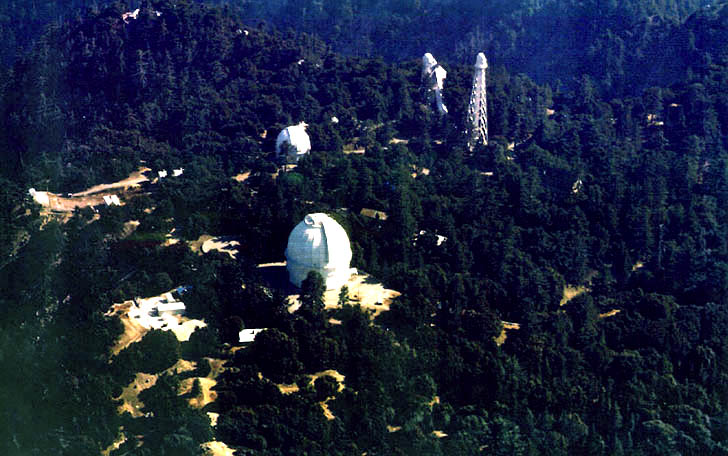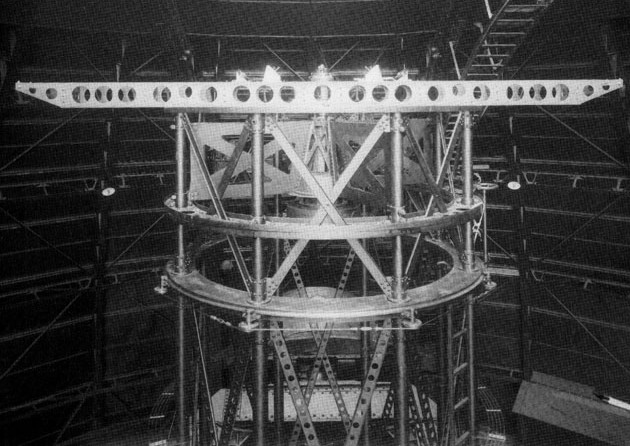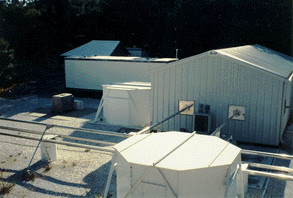Before CHARA
The following picture depicts what Mount Wilson looked like just prior to construction of the CHARA Array. For more information on the history the Observatory, visit the Mount Wilson website.

CHARA is not the first interferometer at Mount Wilson.
The Michelson interferometer

The Pease interferometer

The Mark III interferometer

Building CHARA
Encouraged by the success of the program of binary star speckle interferometry initiated at Georgia State in 1977, the Center for High Angular Resolution Astronomy (CHARA) was established in 1984 with the goal of promoting, designing, funding and operating a major new instrument capable of achieving new levels of angular resolution. Such an instrument would be able to measure the sizes of thousands of stars, see the individual components of binary stars gravitationally bound together in orbits having periods as short as one day, and even detect and image surface details on stars whose existence has only been inferred.
Preliminary planning for this new instrument began in earnest in 1985 with seed money from the National Science Foundation. The NSF provided additional support for detailed engineering studies in 1992 and in October 1994 awarded Georgia State $5.6-million towards construction of a five-telescope array. Additional supplements increased the NSF capital investment to nearly $6.3-million. Over the course of construction of the project, the University has provided matching funds in a similar amount. Following a final site selection process, Mount Wilson, California, home of the historic Mount Wilson Observatory, was selected as the site for the CHARA Array. Ground was broken on July 13, 1996.
In July 1998, the W.M. Keck Foundation awarded Georgia State $1.5-million to add a sixth telescope and to improve the beam combination instrumentation. Funding for the project was completed in October 1998 with a gift from the David and Lucile Packard Foundation of $574,000.
A significant milestone in the project was the attainment of "first fringes" from our southern pair of telescopes in November 1999. This demonstrated the basic soundness of the design for the many subsystems of the Array and gave added confidence that the instrument could meet its scientific goals.
With nearly 300 people in attendance, the CHARA Array was dedicated on October 4, 2000. On September 19, 2001 the Array achieved starlight fringes on its 331-meter baseline, the longest baseline (by a factor of three) ever achieved by an optical interferometer. The Cleon C. Arrington Remote Operations Center for the CHARA Array, located on the Georgia State campus in Atlanta, was dedicated on February 28, 2002. This facility is permitting GSU faculty, staff and students to participate in observing activities at the Array on Mt. Wilson, enabling the remote control of all CHARA facilities from across the country.
By the end of 2002, the Array had made the transition to an active science instrument, and the NSF awarded CHARA a new three-year grant to support scientific programs in April 2003 and renewed that support for another three-year term in 2006. While the construction of the CHARA Array was completed in 2003, technical improvements in both hardware and software will continue indefinitely. Indeed, one rationale for the facility is to serve as a testbed for new developments in optical interferometry.
With this in mind, CHARA has entered into several collaborations with groups offering unique instruments or technologies for enhanced performance. At present these collaborations include a joint observing effort with astronomers from the Laboratoire d'Etudes Spatiales et d'Instumentation en Astrophysique (LESIA) of the Observatoire de Paris who have located their "Fiber Linked Unit for Optical Recombination" (FLUOR) at the CHARA Beam Synthesis Facility. A collaboration with astronomers from the University of Michigan has led to the development of an imaging beam combiner (MIRC) which has produced the first images of stellar surfaces and close binary stars. An agreement between GSU and L'Observatoire de la Cote d'Azur (France) has brought VEGA beam combiner to the Array capable of providing spectroscopic and polarimetric channels for high spectral resolution work. Finally, a joint project between CHARA and astronomers from the University of Sydney (Australia) has led to the development the PAVO beam combiner with significantly improved sensitivity to fainter objects while also providing measurements of very high precision. These international collaborations have brought significant added value to the science capabilities of the CHARA Array.
With growing demand in the astronomical community for high resolution observations obtained through long baseline interferometry, CHARA initiated an open access program in 2010. Initially, CHARA offered a small amount of time consisting of 5-10 nights per year to the broader community as a trial program. Starting in 2016, CHARA received funding through the National Science Foundation's Mid-Scale Innovations Program to expand the open access time to 50-75 nights per year to the astronomical community. Astronomers can apply for time at the CHARA Array through the time allocation process at the National Optical-Infrared Astronomy Research Laboratory. Demand for time at the Array is high with an average over-subscription rate of 2.3. As of 2020, almost 300 astronomers from across the country and around the world have applied for time through the open access program.
The next generation of instrumentation is underway at the CHARA Array. Implementation of adaptive optics systems at each of the six CHARA telescopes is nearly complete. In a collaboration between the University of Exeter and the University of Michigan, the MIRC-X beam combiner was recently upgraded with an ultra-low read noise detector and new input optics to improve sensitivity and wavelength coverage. The University of Michigan will also install a six-telescope cryogenic beam combiner called MYSTIC that will operate at longer wavelengths. The team at l'Observatoire de la Cote d'Azur is planning to build the next generation optical instrument SPICA that will combine all six-telescopes and provide a range of spectral dispersions at visible wavelengths. Motivated by the push toward fainter sensitivity, Georgia State University received funding to upgrade the detector for the CLASSIC and CLIMB combiners.



